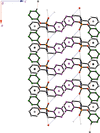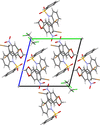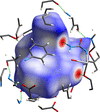issue contents
September 2023 issue

Cover illustration: A tennimide macrocycle resides on a twofold axis and adopts an alternate (syn/anti)2 conformation with no inner cavity (niche), unlike all previously reported (syn)4 tennimide conformations. A partial occupancy water molecule (with 0.167 site occupancy) at hydrogen-bonding distances to two symmetry-related carbonyl O atoms (as O—H⋯O=C) resides on the twofold axis in a molecular niche between two of the pyridine rings. Macrocycle aggregation occurs as one-dimensional chains along the (010) direction. See Mocilac, Pohl & Gallagher [Acta Cryst. (2023). E78, 837–841].
modern approaches and tools for teaching crystallography
A compilation of articles with a strong teaching element published since 2018 is presented alongside an overview of the articles in the special issue on this topic.
research communications
Download citation


Download citation


Two new single-enantiomer phosphorus structures were studied. Their geometries, conformations and NMR features are discussed.
Download citation


Download citation


The title compound was prepared via a modified Mannich reaction between 2-methoxyethylamine, 2,4-dichlorophenol, and aqueous formaldehyde. The resulting amine bis(phenol) provides an interesting comparison to related species as a result of the electron-withdrawing substituents on the phenol rings, in combination with similar steric parameters.
CCDC reference: 2067395
Download citation


Download citation


The crystal structures of three xylitol derivatives prepared directly from commercially available xylitol by treatment with formalin and acid followed by subsequent derivatization of the primary hydroxyl group of the bis-methylene ketal with mesyl chloride, benzyl bromide or phenyl isocyanate are reported.
Download citation


Download citation


[(2-{[6-(1,3-Benzothiazol-2-yl)pyridin-2-yl]carbonylazanidyl}phenyl)sulfanido]nickel(II) crystallizes in the centrosymmetric monoclinic space group P21/n. Both arms of the expected bis-Schiff base ligand based on pyridine-2,6-dicarbaldehyde and 2-aminothiophenol had oxidized; one by cyclization to a benzothiazole, the other by oxidation of its imine linkage to the corresponding amide.
CCDC reference: 2285993
Download citation


Download citation


In the crystal, pairs of molecules are linked by O—H⋯O and N—H⋯O hydrogen bonds forming dimers with ![[R_{2}^{2}]](/e/issues/2023/09/00/tx2072/teximages/tx2072fi1.svg) (14) motifs. These dimers are connected by O—H⋯O hydrogen bonds into chains along the a-axis direction, forming
(14) motifs. These dimers are connected by O—H⋯O hydrogen bonds into chains along the a-axis direction, forming ![[R_{2}^{2}]](/e/issues/2023/09/00/tx2072/teximages/tx2072fi1.svg) (16) ring motifs. Further O—H⋯O interactions involving the ethanol solvent molecule connect the chains into a three-dimensional network.
(16) ring motifs. Further O—H⋯O interactions involving the ethanol solvent molecule connect the chains into a three-dimensional network.
CCDC reference: 2286318
Download citation


Download citation


The crystal structure of a hydrogen-bonded dimer of (triethylazaniumyl)acetic acid and (triethylazaniumyl)acetate bromide features a carboxylic acid hydrogen atom that is engaged in an asymmetric hydrogen bond with the carboxylate oxygen. The crystal also features intramolecular C—H hydrogen bonds and a layer of bromide ions that is surrounded by alkyl groups.
CCDC reference: 2286618
Download citation


Download citation


A new copper(II) complex with 3-methylbenzoate and 2,2′-bipyridine synthesized displays chains of hydrogen-bonded complex units along the b axis. Hirshfeld surface analysis indicates that H⋯H and H⋯C/C⋯H contacts are the most important interactions.
CCDC reference: 2117143
Download citation


Download citation


In the crystal, the 2-amino-5-{(1E)-1-[(carbamothioylamino)imino]ethyl}-4-methyl-1,3-thiazol-3-ium cations are linked by O—H⋯Cl, N—H⋯Cl, N—H⋯O, N—H⋯S and C—H⋯S hydrogen bonds, forming a tri-periodic network.
CCDC reference: 2288159
Download citation


Download citation


The title indole derivative crystallizes with a partial occupancy [0.585 (4)] CHCl3 solvent molecule. The dihedral angles between the indole ring system and pendant nitrobenzodioxolane rings system and phenylsulfonyl ring are 4.81 (14) and 72.24 (19)°, respectively. In the crystal, the indole molecules are linked to each other and to the chloroform molecule by weak C—H⋯O, C—H⋯Cl, C—H⋯π, C—Br⋯π and C—Cl⋯π and aromatic π–π stacking interactions.
CCDC reference: 2279852
Download citation


Download citation


In the crystal structure of the title compound, the triazole ring exhibits interplanar angles of ca 64 and 77° with the phenyl and benzothiazole planes, respectively. The packing involves three borderline C—H⋯N contacts and a pairing of the triazole rings across an inversion centre.
CCDC reference: 2287438
Download citation


Download citation


The isostructural compounds I and II are composed of planar macrocyclic cations [M(cyclam)]2+ and the tetrahedral anion [CdI4]2−, which plays a purely charge-compensation function in the NiII complex I and is axially coordinated via the iodide atom in the ZnII complex II. In both complexes, as a result of N–H⋯I hydrogen bonding, the alternating cations and anions form chains running along the b-axis direction that are arranged into di-periodic sheets oriented parallel to the (101) and (![[\overline{1}]](/e/issues/2023/09/00/ex2074/teximages/ex2074fi1.svg) 01) planes.
01) planes.
Download citation


Download citation


The low-temperature (90 K) crystal structure of 4-(dimethylazaniumyl)-2-hydroxyanilinium dichloride monohydrate is presented along with a Hirshfeld surface analysis of the organic cation.
CCDC reference: 2289098
Download citation


Download citation


9-Methoxy-3,4,5,6-tetrahydro-1H-benzo[b]azonine-2,7-dione and 6-methoxy-1,2,3,4-tetrahydrocarbazole represent the structures of a benzoazonine that contains a nine-membered ring and its parent tetrahydrocarbazole. The molecules of the former pack together via strong amide N—H⋯O hydrogen bonding and weak C—H⋯O interactions, whereas the parent tetrahydrocarbazole packs with C/N—H⋯π interactions, as visualized by Hirshfeld surface characterization.
Download citation


Download citation


The tennimide macrocycle (I) resides on a twofold axis and adopts an alternate (syn/anti)2 conformation with no inner cavity (niche), unlike all previously reported (syn)4 tennimide conformations. A partial occupancy water molecule (with 0.167 site occupancy) at hydrogen-bonding distances to two symmetry-related carbonyl O atoms (as O—H⋯O=C) resides on the twofold axis in a molecular niche between two of the pyridine rings. Macrocycle aggregation occurs as one-dimensional chains along the (010) direction.
CCDC reference: 2286597
Download citation


Download citation


Synthesis, characterization and crystal structure of methyl 2-(2-oxo-2H-chromen-4-ylamino)benzoate
A new coumarin derivative, methyl 2-(2-oxo-2H-chromen-4-ylamino)benzoate, has been synthesized and characterized.
CCDC reference: 2289922
Download citation


Download citation


In the crystal of (2E)-1-(4-bromophenyl)-3-(2-methylphenyl)prop-2-en-1-one, the molecules are linked into chains by weak C—H⋯O interactions along the b axis. Successive chains form a zigzag structure along the c axis, and these chains are connected to each other by face-to-face π–π stacking interactions along the a axis, forming layers parallel to the (001) plane. The crystal structure maintains its stability via van der Waals interactions between the layers.
CCDC reference: 2290092
Download citation


Download citation


The first high-quality crystal structure of unmodified 2′-deoxyguanosine is reported. The isolated crystals are the dimethyl sulfoxide disolvate.
CCDC reference: 2290127
Download citation


Download citation


The organic–inorganic hybride salt (C9H10N2)[ZnCl4] consists of a planar 8-azaniumylquinolinium dication and a tetrahedral tetrachloridozincate(II) dianion, held together by N—H⋯Cl and C—H⋯Cl hydrogen bonds, and π—π interactions.
CCDC reference: 2290822
Download citation


Download citation


The molecular and crystal structures of a cadmium acetate coordination compound with 2-aminobenzoxazole were studied, and the Hirshfeld surfaces and fingerprint plots were generated to investigate various intermolecular interactions.
CCDC reference: 2290113

 journal menu
journal menu









































